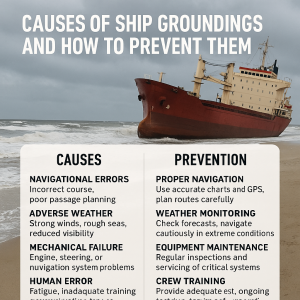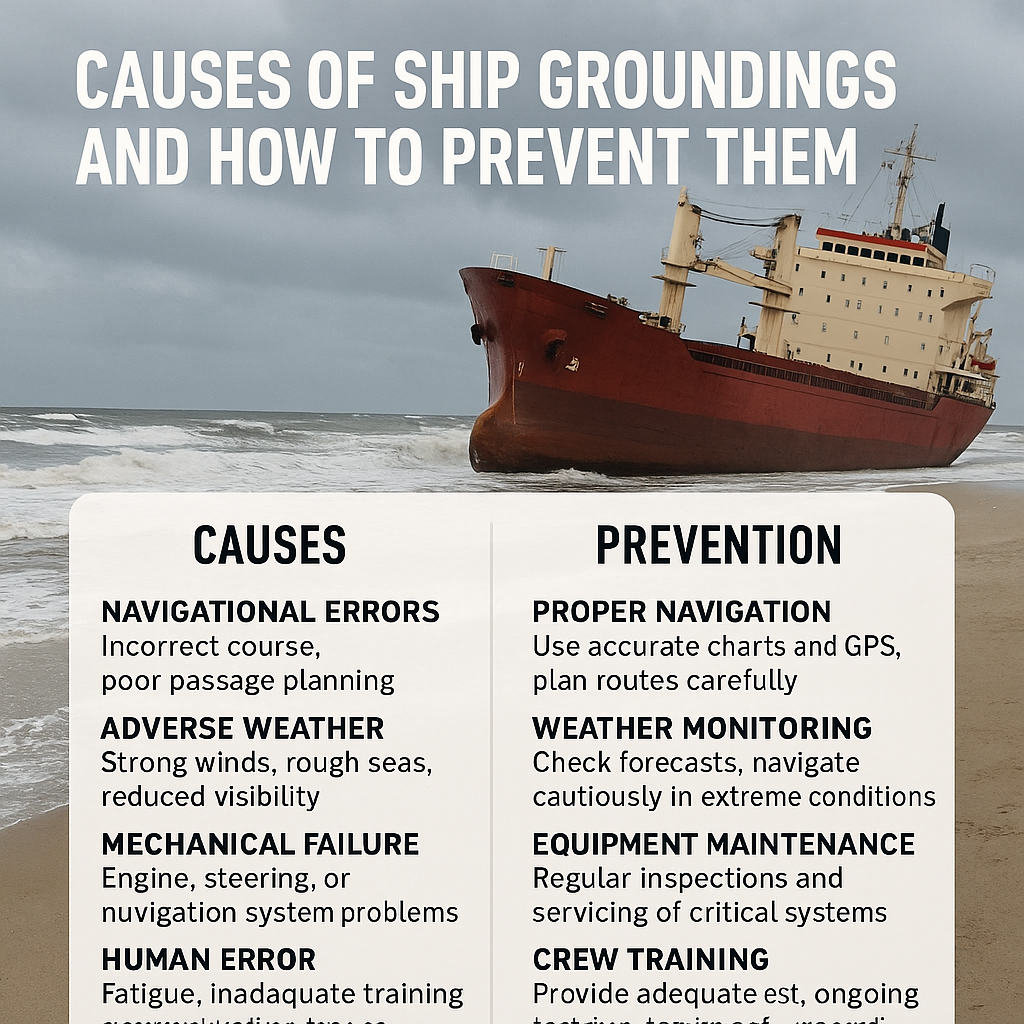Discover the top 10 causes of ship groundings and how to prevent them. Learn from real-world incidents and expert recommendations to keep vessels and crew safe at sea.

Maritime history is filled with cautionary tales of ships meeting land where they shouldn’t. From the dramatic beaching of the Ever Given in the Suez Canal to smaller groundings in coastal waters, the risks are real and recurring. Grounding is one of the most common and costly maritime incidents, often leading to vessel damage, environmental harm, and major trade disruptions. Groundings may seem like simple navigational mistakes, but in reality, they often involve a complex chain of human, mechanical, and environmental factors. Fortunately, with proper awareness and preventive strategies, most groundings are avoidable.
Why Ship Groundings Matter in Maritime Operations
Ship groundings are more than just embarrassing mishaps; they are high-risk events with far-reaching consequences. According to the International Union of Marine Insurance (IUMI), groundings account for nearly 30% of all hull and machinery claims. The International Maritime Organization (IMO) and port authorities have ramped up pressure on shipping companies to adopt safer navigation protocols, especially in confined and congested waters.
Moreover, groundings often lead to significant environmental consequences. The 2002 grounding of the Prestige oil tanker off the coast of Spain spilled over 60,000 tonnes of oil, affecting over 1,000 km of shoreline. The cost? Billions in cleanup, legal penalties, and reputational damage. In this context, understanding and mitigating grounding risks is a shared responsibility between mariners, shipping companies, regulators, and technology developers.
The Top 10 Causes of Ship Groundings (With Prevention Strategies)
1. Human Error and Poor Watchkeeping
According to the UK Marine Accident Investigation Branch (MAIB) and the US Coast Guard, human error is the leading cause of ship groundings globally. This includes fatigue, distraction, lack of situational awareness, or failure to follow bridge resource management (BRM) protocols.
Prevention:
- Implement proper BRM training (as per IMO Model Course 1.22)
- Enforce STCW watchkeeping standards
- Promote a culture of alertness and accountability
2. Inadequate Voyage Planning
Voyage planning errors, including outdated charts, miscalculated under-keel clearance, or neglected tidal data, are a major contributor. A 2021 MAIB report cited several cases where captains failed to consult available Notices to Mariners.
Prevention:
- Comply with SOLAS Chapter V Regulation 34 on voyage planning
- Use up-to-date ECDIS with integrated tidal overlays
- Conduct risk assessments for critical navigational legs
3. Navigation Equipment Failure or Misuse
Faulty radar, incorrect GPS settings, or failure to properly use ECDIS can mislead navigators. In many cases, officers rely blindly on electronic aids without cross-verifying with paper charts or visual bearings.
Prevention:
- Regular bridge equipment checks as per ISM Code Chapter 10
- Conduct ECDIS simulation training (IMO Model Course 1.27)
- Emphasize manual cross-checks during officer training
4. Poor Communication Between Bridge Team and Pilots
Misunderstandings or assumptions during pilotage often lead to delayed course changes or incorrect manoeuvres. Even experienced pilots may not be fully briefed on the ship’s characteristics.
Prevention:
- Conduct a thorough Master-Pilot Exchange (MPX)
- Use standard marine communication phrases (SMCP)
- Monitor pilot decisions continuously and collaboratively
5. Fatigue and Undermanning
Chronic fatigue reduces alertness and impairs decision-making. The International Transport Workers’ Federation (ITF) highlights that fatigue is endemic in vessels with tight turnaround schedules and minimal crew.
Prevention:
- Adhere to ILO/IMO STCW rest hour limits
- Schedule proper watch rotation and rest breaks
- Use fatigue risk management tools (e.g., bio-mathematical models)
6. Mechanical or Steering Gear Failure
Malfunctions in steering systems, propulsion, or thrusters can lead to unintended deviations. This is particularly dangerous near shorelines or port approaches.
Prevention:
- Routine inspections under Classification Society (e.g., DNV, ABS) standards
- Test steering systems before arrival and departure
- Carry out emergency steering drills (SOLAS Reg II-1/29)
7. Poor Visibility and Adverse Weather
Fog, storms, and reduced visibility can make even well-prepared voyages vulnerable. Storm surge or unexpected squalls can push ships into shallows.
Prevention:
- Monitor real-time weather updates via NAVTEX and Inmarsat
- Adjust speed and CPA in poor visibility
- Use radar plotting and parallel indexing
8. Overreliance on Technology
Too much faith in GPS or autopilot has led to complacency. When systems fail or mislead, crews often react too late.
Prevention:
- Reinforce traditional navigation skills (sextant, bearings)
- Use Bridge Team Management drills without GPS/ECDIS
- Embrace a hybrid approach: “Trust, but verify”
9. Improper Ballast or Trim Conditions
Incorrect ballast can lead to excessive draft or uneven trim, increasing grounding risk. A heavy bow, for instance, can drag in shallow waters.
Prevention:
- Monitor draft continuously using tank sounding and inclinometer data
- Follow the IMO Ballast Water Management Convention
- Trim vessels appropriately for expected sea and berth conditions
10. Environmental and Seabed Changes
Shifting sands, silting, or uncharted underwater obstructions can surprise even experienced navigators. Climate-induced changes in seabed topography make it worse.
Prevention:
- Use real-time depth sounding (echo sounders, forward-looking sonar)
- Keep charts updated with latest Hydrographic Office data
- Request local seabed surveys in areas with known silting
–
Real-World Examples and Lessons
- Ever Given (2021): The grounding of this ultra-large container ship in the Suez Canal blocked global trade for six days. Investigations pointed to wind effects, speed misjudgment, and pilot decision delays.
- MV Wakashio (2020): Ran aground on a reef off Mauritius, spilling over 1,000 tonnes of oil. The root cause? Deviation from course to seek mobile signal and poor lookout.
- Pasha Bulker (2007): Grounded on Nobbys Beach in Australia during a storm. The captain ignored gale warnings and failed to move to deeper waters in time.
These cases reinforce the importance of proactive decision-making, real-time monitoring, and adherence to protocol.
Challenges and Solutions in Grounding Prevention
Challenges:
- Diverse skill levels across multinational crews
- Pressure from charterers for quick turnarounds
- Legacy vessels lacking modern navigation aids
Solutions:
- Enhanced bridge simulator training through IMO Model Courses
- Adoption of AI-powered voyage planning tools (e.g., NAPA, StormGeo)
- Mandating Safety Management System (SMS) updates in line with near-miss reports
Organizations like the Nautical Institute, IMAREST, and BIMCO are actively publishing best practices and sponsoring training programs to reduce grounding incidents globally.
Frequently Asked Questions (FAQ)
What is a ship grounding? Ship grounding occurs when a vessel’s hull comes into contact with the seabed, usually unintentionally.
Is grounding the same as beaching? No. Grounding is typically accidental; beaching is intentional (e.g., shipbreaking).
Can ship groundings be predicted? While specific incidents can’t always be predicted, risk factors like shallow waters, poor planning, or mechanical issues can be monitored and mitigated.
Do modern ships still run aground? Yes, even with advanced technology. Human error, poor planning, and equipment failure remain common causes.
What are the consequences of grounding? Consequences include hull damage, cargo loss, pollution, legal claims, and detention by port state control.
Are groundings covered by insurance? Typically, yes. Hull & Machinery insurance and P&I clubs cover grounding-related claims, but negligence can complicate payouts.
Conclusion
Ship groundings are among the most preventable maritime accidents. Yet, they continue to challenge the industry due to a mix of human factors, environmental unpredictability, and equipment limitations.
The good news? With rigorous training, better voyage planning, smarter use of technology, and a strong safety culture, most groundings can be avoided. Whether you’re a deck officer, engineer, or shipowner, staying alert and informed is your strongest anchor against disaster.
References
- International Maritime Organization (IMO)
- Marine Accident Investigation Branch (UK)
- US Coast Guard Navigation Center
- BIMCO – Safety & Security
- The Nautical Institute – Bridge Resource Management
- Inmarsat Maritime Safety
- DNV Steering Gear Rules
- STCW Convention and Code
- International Transport Workers’ Federation (ITF)
- World Maritime University Journal
- Marine Insight – Navigation

